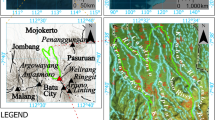Abstract
A three level classification system, based on the genesis of landforms, was used to map the geomorphology of the Goa state. The first level corresponds to the process that was responsible for landform generation, the second level or the intermediate level was assigned based on the morphography, and the third level corresponds to the individual landforms units identified based on the morphostructure. The map** was carried out using IRS-P6 LISS-III (23.5 m) satellite image as the primary data source. Ancillary data such as geological map, topographic map, digital elevation model (DEM), field data collected by global positioning system (GPS) and web portals for image visualisation, were also used for the map** purpose. A new software designed for map** landforms based on the genesis, was used in this study to create a seamless geomorphology and lineament database of the Goa state in a GIS environment. A total of 58 landforms within six types of genetic classes were mapped in this area. Similarly, structural and geomorphic lineaments were also delineated using the satellite data. The database created has multi-purpose usability such as environmental studies, mining activity assessment, coastal zone management and wasteland development, since the classification system used is focused on processes, not theme specific.















Similar content being viewed by others
References
Alcantara-Ayala, I. (2002). Geomorphology, natural hazards, vulnerability and prevention of natural disasters in develo** countries. Geomorphology, 47, 107–124.
Anand, V. K., Venkataraman, G., & Rao, G. S. K. (1987). Some aspects of geomorphic processes along the Goa coast through remote sensing. Journal of Indian Society of Remote Sensing, 15, 49–54.
Chakraborty, T., & Ghosh, P. (2010). The geomorphology and sedimentology of the Tista megafan, Darjeeling Himalaya: implications for megafan building processes. Geomorphology, 115, 252–266.
GSI. (1996). Geological and mineral map of Goa.
GSI & NRSC. (2010). Manual for national geomorphological and lineament map** on 1:50,000 scale (Document control number: NRSC-RS&GISAA-ERG-G&GD-FEB’ 10-TR149). Hyderabad, National Remote Sensing Centre.
Gustavsson, M. (2006). Development of a detailed geomorphological map** system and GIS geodatabase in Sweden (p. 36). Phd Thesis, University of Uppsala.
Iwahashi, J., & Pike, R. J. (2007). Automated classifications of topography from DEMs by an unsupervised nested-means algorithm and a three-part geometric signature. Geomorphology, 86, 409–440.
Javed, A., Khanday, M. Y., & Ravi, S. (2011). Watershed prioritization using morphometric and LULC parameters: a remote sensing and GIS based approach. Journal of Geological Society of India, 78, 63–75.
Javed, A., & Wani, M. H. (2009). Delineation of Groundwater potential zones in Kakund watershed, Eastern Rajasthan, using RS and GIS techniqus. Journal of Geological Society of India, 73, 229–236.
Kruse, F. A. (2012). Map** surface mineralogy using imaging spectrometry. Geomorphology, 137, 41–56.
Kunte, P. D. (1990). Landsat image enhancement and analysis approach for geological studies of Central Part of Goa, India. Journal of the Indian Society of Remote Sensing, 18, 32–42.
Ott, N., Kollersberger, T., & Tassara, A. (2006). GIS analysis and favourability map** of optimized satellite data in Northern Chile to improve exploration for copper mineral deposits. Geosphere, 2, 236–252.
Scarciglia, F., Pulice, I., Robustelli, G., & Vecchio, G. (2006). Soil chronosequences on Quaternary marine terraces along the northwestern coast of Calabria (Southern Italy). Quaternary International, 156–157, 133–155.
Singh, B., & Dowerah, J. (2010). ASTER DEM based studies for geological investigation around Singhbhum Shear Zone (SSZ) in Jharkhand, India. Journal of Geographic Information System, 2, 11–14.
Toutin, T. (2008). ASTER DEMs for geomatic and geoscientific applications: a review. International Journal of Remote Sensing, 29, 1855–1875.
Townsend, A. P., Kingdon, C. C., & Eshleman, N. K. (2009). Changes in the extent of the surface mining and reclamation in Central Appalachians detected using a 1976–2006 Landsat time series. Remote Sensing of Environment, 113, 62–72.
Van Westen, C. J., Rengers, N., & Soeters, R. (2003). Use of geomorphological information in indirect susceptibility assessment. Natural Hazards, 30, 399–419.
Wagle, B. G. (1982). Geomorphology of the Goa coast. Proceedings of lndian Academy of Sciences, 91, 105–115.
Wagle, B. G. (1993). Geomorphology of Goa and Goa Coast. Giornale di Geologia, 55(2), 19–24.
Acknowledgments
This study was carried out as a part of the national geomorphological and lineament map** project. We thank Dr. V. K. Dadhwal, Director, NRSC, Dr. Y. V. N. Krishnamurthy, Deputy Director (RSA-A), NRSC, and Shri G. Behera, former Deputy Director (RSGIS-AA), NRSC for their encouragement and support to carry out this work. We are grateful to Shri V. Singaraju and Dr. L. P. Singh, Sr. geologists at GSI, Hyderabad, for their valuable suggestions. We gratefully acknowledge the help and facilities provided by the Goa State Remote Sensing Centre during the fieldwork
Author information
Authors and Affiliations
Corresponding author
About this article
Cite this article
Martha, T.R., Ghosh, D., Kumar, K.V. et al. Geospatial Technologies for National Geomorphology and Lineament Map** Project – A Case Study of Goa State. J Indian Soc Remote Sens 41, 905–920 (2013). https://doi.org/10.1007/s12524-012-0260-1
Received:
Accepted:
Published:
Issue Date:
DOI: https://doi.org/10.1007/s12524-012-0260-1




